Are You Suffering From Ingrown Toenails?
Foot Care Tips for Marathon Runners
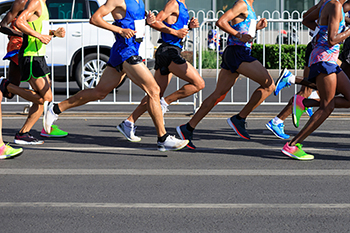
For a marathon or long distance runner, the feet play an extremely important role. For this reason, attention to the type of footwear that is chosen is paramount. One of the first concerns is the support and cushioning that is needed. Shoes that are too minimal in these aspects may cause excruciating pain after running 26.2 miles. Some shoes can be too stiff, and others not stiff enough. Arch support and cushioning are two concerns that must be addressed when buying running shoes. If your arches hurt, it may be wise to consider having custom orthotics made by a podiatrist to counteract this problem. Gel inserts are another option. Performing a series of foot exercises may help maintain good health of the soles of the foot and preventing plantar fasciitis. Rolling the foot over a tennis ball, or frozen water bottle, performing toe splay exercises, and rotating the ankles also may help. This can be followed by soaking the feet in a warm foot bath with Epsom salts. For help with foot pain of any sort after running a marathon, it is suggested that you make an appointment with a podiatrist.
Exercising your feet regularly with the proper foot wear is a great way to prevent injuries. If you have any concerns about your feet, contact Harvey Jacobs, DPM of Quality Foot Care Center. Our doctor will treat your foot and ankle needs.
How to Prevent Running Injuries
Many common running injuries are caused by overuse and overtraining. When the back of the kneecap starts wearing out and starts causing pain in your knee, this is commonly referred to as runner’s knee. Runner’s knee is a decrease in strength in your quadriceps and can occur if you’re not wearing properly fitted or supporting shoes. To prevent runner’s knee, focusing on hip strengthening is a good idea, as well as strengthening your quads to keep the kneecaps aligned.
What Are Some Causes of Running Injuries?
- One cause of a common running injury is called iliotibial band syndrome.
- Plantar fasciitis is also another common injury.
- Stress fractures can occur from overtraining, lack of calcium, or even your running style.
Best Ways to Prevent Running Injuries
- Wear footwear that fits properly and suits your running needs.
- Running shoes are the only protective gear that runners have to safeguard them from injury.
- Make a training schedule. Adding strengthening exercises as well as regular stretching can help keep you strong and limber and can lessen the possibility of injuries.
- Stretching keeps muscles limber; this will help you gain better flexibility.
If you have any questions please feel free to contact our office located in Somerset, NJ . We offer the newest diagnostic and treatment technologies for all your foot and ankle needs.
Diabetes and Podiatry
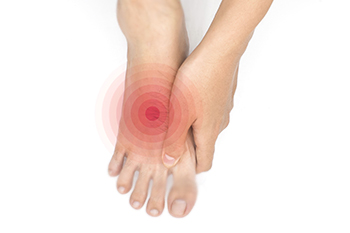
Diabetes can affect the feet, and complications may ensue. Practicing a daily diabetic foot care routine is crucial in protecting the feet from this serious disease, and there are simple methods that can accomplish this. These can include washing and drying the feet daily, followed by inspecting the soles. Many people use a mirror to do this, or possibly have a family member or caregiver help them, if available. The skin can be kept smooth by using a good moisturizer, and it is important to refrain from applying it between the toes. It may be helpful to wear socks that have extra cushioning and do not have elastic tops. These types of socks are designed for diabetic patients and are also made from materials that can absorb moisture. Nerve damage, or neuropathy can often accompany diabetes, which is the inability to feel existing cuts or scrapes that are on the bottom of the feet. It is advised against walking barefoot at any time, which may help to protect the feet from incurring wounds. If you have diabetes, it is strongly suggested that you are under the care of a podiatrist who can help to manage this condition.
Diabetic foot care is important in preventing foot ailments such as ulcers. If you are suffering from diabetes or have any other concerns about your feet, contact Harvey Jacobs, DPM from Quality Foot Care Center. Our doctor can provide the care you need to keep you pain-free and on your feet.
Diabetic Foot Care
Diabetes affects millions of people every year. The condition can damage blood vessels in many parts of the body, especially the feet. Because of this, taking care of your feet is essential if you have diabetes, and having a podiatrist help monitor your foot health is highly recommended.
The Importance of Caring for Your Feet
- Routinely inspect your feet for bruises or sores.
- Wear socks that fit your feet comfortably.
- Wear comfortable shoes that provide adequate support.
Patients with diabetes should have their doctor monitor their blood levels, as blood sugar levels play such a huge role in diabetic care. Monitoring these levels on a regular basis is highly advised.
It is always best to inform your healthcare professional of any concerns you may have regarding your feet, especially for diabetic patients. Early treatment and routine foot examinations are keys to maintaining proper health, especially because severe complications can arise if proper treatment is not applied.
If you have any questions please feel free to contact our office located in Somerset, NJ . We offer the newest diagnostic and treatment technologies for all your foot and ankle needs.
What Can Cause Morton's Neuroma?

A burning pain in the ball of the foot and the feeling of having a small pebble under your foot are signs that you may have Morton’s neuroma. This condition involves a thickening of the tissue across the metatarsal nerves, causing pressure and pain. It is generally felt in the space between the third and fourth toes, and may be connected to the type of shoes that are worn. High heels with pointed toes and shoes that are too tight can cause pressure on the metatarsal joints by pushing the weight onto the ball of the foot. Certain foot deformities, such as hammertoes or bunions, can cause the weight of the body to shift onto the ball of the foot. High impact sporting activities, such as tennis and running, can place increased stress in the area. Additionally, rock climbers and snow skiers may develop Morton’s neuroma, as a result of a combination of wearing tight shoes that can exert pressure on the toes. For a diagnosis and treatment options, it is suggested that you make an appointment with a podiatrist.
Morton’s neuroma is a very uncomfortable condition to live with. If you think you have Morton’s neuroma, contact Harvey Jacobs, DPM of Quality Foot Care Center. Our doctor will attend to all of your foot care needs and answer any of your related questions.
Morton’s Neuroma
Morton's neuroma is a painful foot condition that commonly affects the areas between the second and third or third and fourth toe, although other areas of the foot are also susceptible. Morton’s neuroma is caused by an inflamed nerve in the foot that is being squeezed and aggravated by surrounding bones.
What Increases the Chances of Having Morton’s Neuroma?
- Ill-fitting high heels or shoes that add pressure to the toe or foot
- Jogging, running or any sport that involves constant impact to the foot
- Flat feet, bunions, and any other foot deformities
Morton’s neuroma is a very treatable condition. Orthotics and shoe inserts can often be used to alleviate the pain on the forefront of the feet. In more severe cases, corticosteroids can also be prescribed. In order to figure out the best treatment for your neuroma, it’s recommended to seek the care of a podiatrist who can diagnose your condition and provide different treatment options.
If you have any questions, please feel free to contact our office located in Somerset, NJ . We offer the newest diagnostic and treatment technologies for all your foot care needs.
Two Categories of Flat Feet
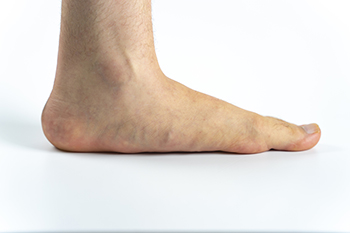
Pain can sometimes occur in people who have flat feet. The majority of babies are born with flat feet, and this may extend into adulthood. Flat feet are defined as the foot having no arch or very low arches. This can cause an inability for the foot to lie flat on the ground and can affect posture. Some of the symptoms that patients may have with flat feet are swelling, pain, and stiffness, which may indicate an underlying disorder in adults. Flat feet can affect the alignment of the body and can compromise walking, standing, and running. The two categories of flat feet can include flexible and rigid. Children are more affected by flexible flat feet, and the arch cannot be seen while standing but will reappear while sitting down. The arch is non-existent in people who have rigid flat feet, regardless of any weight that is put on the foot. There are specific stretches that can be done to strengthen the foot. If you have flat feet, it is strongly suggested that you are under the care of a podiatrist who can help you with relief techniques.
Flatfoot is a condition many people suffer from. If you have flat feet, contact Harvey Jacobs, DPM from Quality Foot Care Center. Our doctor will treat your foot and ankle needs.
What Are Flat Feet?
Flatfoot is a condition in which the arch of the foot is depressed and the sole of the foot is almost completely in contact with the ground. About 20-30% of the population generally has flat feet because their arches never formed during growth.
Conditions & Problems:
Having flat feet makes it difficult to run or walk because of the stress placed on the ankles.
Alignment – The general alignment of your legs can be disrupted, because the ankles move inward which can cause major discomfort.
Knees – If you have complications with your knees, flat feet can be a contributor to arthritis in that area.
Symptoms
- Pain around the heel or arch area
- Trouble standing on the tip toe
- Swelling around the inside of the ankle
- Flat look to one or both feet
- Having your shoes feel uneven when worn
Treatment
If you are experiencing pain and stress on the foot you may weaken the posterior tibial tendon, which runs around the inside of the ankle.
If you have any questions please feel free to contact our office located in Somerset, NJ . We offer the newest diagnostic and treatment technologies for all your foot and ankle needs.
Why Live with Pain and Numbness in Your Feet?
Diabetic Patients and Neuropathy

Neuropathy affects the nerves throughout the body, including the feet, and it can cause the inability to feel pain in the soles of the feet. Many people who have this condition are unable to feel if their feet are hot or cold, and they may have a consistent tingling or numbing sensation. People who are diabetic can develop neuropathy which can lead to serious consequences as wounds can develop on the bottom of the feet that are not noticed. Untreated wounds in these patients may lead to getting foot ulcers, and it is imperative the bottom of the feet are checked daily. Patients who are afflicted with neuropathy may have difficulty walking, balance may be affected, and it may possibly lead to falling. If you have this condition, it is strongly suggested that you are under the care of a podiatrist who can guide you toward proper management techniques.
Neuropathy
Neuropathy can be a potentially serious condition, especially if it is left undiagnosed. If you have any concerns that you may be experiencing nerve loss in your feet, consult with Harvey Jacobs, DPM from Quality Foot Care Center. Our doctor will assess your condition and provide you with quality foot and ankle treatment for neuropathy.
What Is Neuropathy?
Neuropathy is a condition that leads to damage to the nerves in the body. Peripheral neuropathy, or neuropathy that affects your peripheral nervous system, usually occurs in the feet. Neuropathy can be triggered by a number of different causes. Such causes include diabetes, infections, cancers, disorders, and toxic substances.
Symptoms of Neuropathy Include:
- Numbness
- Sensation loss
- Prickling and tingling sensations
- Throbbing, freezing, burning pains
- Muscle weakness
Those with diabetes are at serious risk due to being unable to feel an ulcer on their feet. Diabetics usually also suffer from poor blood circulation. This can lead to the wound not healing, infections occurring, and the limb may have to be amputated.
Treatment
To treat neuropathy in the foot, podiatrists will first diagnose the cause of the neuropathy. Figuring out the underlying cause of the neuropathy will allow the podiatrist to prescribe the best treatment, whether it be caused by diabetes, toxic substance exposure, infection, etc. If the nerve has not died, then it’s possible that sensation may be able to return to the foot.
Pain medication may be issued for pain. Electrical nerve stimulation can be used to stimulate nerves. If the neuropathy is caused from pressure on the nerves, then surgery may be necessary.
If you have any questions, please feel free to contact our office located in Somerset, NJ . We offer the newest diagnostic and treatment technologies for all your foot care needs.
Genetics and Wearing High Heels May Cause Bunions

People who have bunions report it can be one of the most painful foot conditions to have. It is defined as a bony protrusion that forms on the side of the big toe, and will gradually become larger if treatment is not received. A bunion can be caused by genetic reasons, or from wearing shoes that have a tapered toe area. High heels can fit into this category, and it is beneficial to choose shoes that have a lower heel if these types of shoes need to be worn. Corns and calluses may form on top of the toes, as they touch the top of the shoe. This can be uncomfortable, and mild relief may be felt when the shoes that are worn can accommodate the bunion. If the bunion becomes severe and causes the inability to complete daily activities, surgery may be an option to consider for removal and permanent relief. If you see a bunion that is starting to form, it is suggested that you contact a podiatrist who offers you treatment options that are right for you.
If you are suffering from bunions, contact Harvey Jacobs, DPM of Quality Foot Care Center. Our doctor can provide the care you need to keep you pain-free and on your feet.
What Is a Bunion?
A bunion is formed of swollen tissue or an enlargement of boney growth, usually located at the base joint of the toe that connects to the foot. The swelling occurs due to the bones in the big toe shifting inward, which impacts the other toes of the foot. This causes the area around the base of the big toe to become inflamed and painful.
Why Do Bunions Form?
Genetics – Susceptibility to bunions are often hereditary
Stress on the feet – Poorly fitted and uncomfortable footwear that places stress on feet, such as heels, can worsen existing bunions
How Are Bunions Diagnosed?
Doctors often perform two tests – blood tests and x-rays – when trying to diagnose bunions, especially in the early stages of development. Blood tests help determine if the foot pain is being caused by something else, such as arthritis, while x-rays provide a clear picture of your bone structure to your doctor.
How Are Bunions Treated?
- Refrain from wearing heels or similar shoes that cause discomfort
- Select wider shoes that can provide more comfort and reduce pain
- Anti-inflammatory and pain management drugs
- Orthotics or foot inserts
- Surgery
If you have any questions, please feel free to contact our office located in Somerset, NJ . We offer the newest diagnostic and treatment technologies for all your foot care needs.
Simple Methods to Make Your Feet Feel Good

Some people pay little attention to their feet until foot pain develops. When an everyday foot care routine is practiced, the chances of incurring painful foot conditions may be reduced. Begin with washing and drying the feet daily, then apply a moisturizer. The daily use of moisturizers may help prevent cracked heels from occurring. Ingrown toenails may be avoided when the nails are trimmed properly, which means cutting them straight across instead of in a curved fashion. All-day comfort for the feet and body may be achieved when the right size shoes are worn. Determine your shoe size using a Brannock device, and purchase shoes at the end of the day when the feet are at their largest. The feet can become stronger when daily foot exercises and stretches are performed, possibly making it easier to complete daily activities. If you would like additional techniques about every day foot care procedures, it is suggested that you confer with a podiatrist who can provide you with the correct tips.
Everyday foot care is very important to prevent infection and other foot ailments. If you need your feet checked, contact Harvey Jacobs, DPM from Quality Foot Care Center. Our doctor can provide the care you need to keep you pain-free and on your feet.
Everyday Foot Care
Often, people take care of their bodies, face and hair more so than they do for their feet. But the feet are a very important aspect of our bodies, and one that we should pay more attention to. Without our feet, we would not be able to perform most daily tasks.
It is best to check your feet regularly to make sure there are no new bruises or cuts that you may not have noticed before. For dry feet, moisturizer can easily be a remedy and can be applied as often as necessary to the affected areas. Wearing shoes that fit well can also help you maintain good foot health, as well as making it easier to walk and do daily activities without the stress or pain of ill-fitting shoes, high heels, or even flip flops. Wearing clean socks with closed shoes is important to ensure that sweat and bacteria do not accumulate within the shoe. Clean socks help to prevent Athlete’s foot, fungi problems, bad odors, and can absorb sweat.
If you have any questions please feel free to contact our office located in Somerset, NJ . We offer the newest diagnostic and treatment technologies for all your foot and ankle needs.
Who Can Get Sever’s Disease?
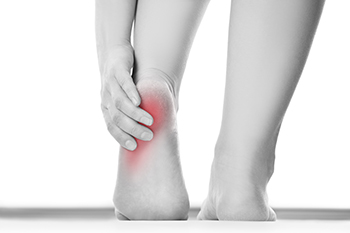
Sever’s disease affects the heel. It can happen in children and young teenagers who frequently participate in running and jumping activities. Parents may notice their child is limping or walking on tiptoes, which are common symptoms of Sever’s disease. This condition can happen as a result of repetitive stress to the heel bone growth area. As the heel grows, the consistent activity may cause the growth plate to heal improperly, possibly causing Sever's disease. The growth plate can be protected by wearing shoes that fit well while engaging in these types of activities. Having good arch support and cushioning may help the heel to recover in a timely manner. Treatment generally begins with temporarily stopping the activity that caused this condition, and it may help to elevate the affected foot as often as possible. If your child has symptoms of Sever’s disease, it is strongly suggested that a podiatrist is consulted as quickly as possible who can provide permanent treatment solutions.
Sever's disease often occurs in children and teens. If your child is experiencing foot or ankle pain, see Harvey Jacobs, DPM from Quality Foot Care Center. Our doctor can treat your child’s foot and ankle needs.
Sever’s Disease
Sever’s disease is also known as calcaneal apophysitis, which is a medical condition that causes heel pain I none or both feet. The disease is known to affect children between the ages of 8 and 14.
Sever’s disease occurs when part of the child’s heel known as the growth plate (calcaneal epiphysis) is attached to the Achilles tendon. This area can suffer injury when the muscles and tendons of the growing foot do not keep pace with bone growth. Therefore, the constant pain which one experiences at the back of the heel will make the child unable to put any weight on the heel. The child is then forced to walk on their toes.
Symptoms
Acute pain – Pain associated with Sever’s disease is usually felt in the heel when the child engages in physical activity such as walking, jumping and or running.
Highly active – Children who are very active are among the most susceptible in experiencing Sever’s disease, because of the stress and tension placed on their feet.
If you have any questions, please feel free to contact our office located in Somerset, NJ . We offer the newest diagnostic and treatment technologies for all your foot and ankle injuries.
More...
Choosing the Right Shoes for Trail Running
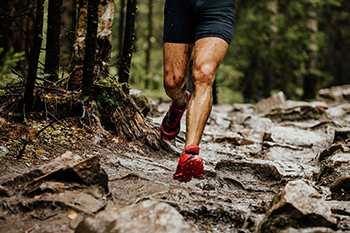
Running on trails requires many precautions that are not needed for other types of exercise or sport. Among the most important considerations is finding the proper footwear. Here are some tips from experts for selecting trail running shoes that can enhance your safety and increase your enjoyment. This type of shoe falls into three categories, including light trails, rugged trails, and off trails. Light trail shoes are made of fairly stiff materials that offer some protection from rocks, but serve well on more groomed trails. Rugged trail shoes are sturdier and have tougher soles that may help to prevent slipping, while providing more stability against foot rotation. They also have thicker exteriors to ward off thorns and brush. Off trail shoes are the most rugged, providing extra protection against rough terrain. They hold up well in bogs, streams and other slippery spots. As with all running footwear, trail running shoes must fit properly, while taking into account the socks that you will wear. For more information on what type of shoes to purchase for trail running, it is suggested that you consult a podiatrist.
All runners should take extra precaution when trying to avoid injury. If you have any concerns about your feet, contact Harvey Jacobs, DPM of Quality Foot Care Center. Our doctor will treat your foot and ankle needs.
How to Prevent Running Injuries
There are a lot of mistakes a runner can make prior to a workout that can induce injury. A lot of athletes tend to overstretch before running, instead of saving those workouts for a post-run routine. Deep lunges and hand-to-toe hamstring pulls should be performed after a workout instead of during a warmup. Another common mistake is jumping into an intense routine before your body is physically prepared for it. You should try to ease your way into long-distance running instead of forcing yourself to rush into it.
More Tips for Preventing Injury
- Incorporate Strength Training into Workouts - This will help improve the body’s overall athleticism
- Improve and Maintain Your Flexibility – Stretching everyday will help improve overall performance
- “Warm Up” Before Running and “Cool Down” Afterward – A warm up of 5-10 minutes helps get rid of lactic acid in the muscles and prevents delayed muscle soreness
- Cross-Training is Crucial
- Wear Proper Running Shoes
- Have a Formal Gait Analysis – Poor biomechanics can easily cause injury
If you have any questions, please feel free to contact our office located in Somerset, NJ . We offer the newest diagnostic and treatment technologies for all your foot care needs.
Do Your Child's Feet Hurt?
Dealing With Uncomfortable Plantar Warts

Warts are caused by a virus. When they develop on the soles of the feet, they may are termed plantar warts. They grow inward as a result of the weight the feet must bear, and can cause severe pain and discomfort. Warts are contagious and are caused by the human papillomavirus, abbreviated as HPV. This virus lives in warm and moist environments, and it can be transmitted between people by sharing shoes, towels, or socks. It is beneficial to wear appropriate shoes while in areas such as public swimming pools, shower room floors, and similar places. Many people choose to wear flip flops or water shoes, and it is helpful to refrain from walking barefoot. A plantar wart is a hard, thick patch of skin, and it often has dark spots in the center. They can cause difficulty in walking, and many patients may alter their gait, which may help to reduce existing pain. If you have a wart on the bottom of your foot, it is suggested that you consult with a podiatrist who can offer you one of various treatments for plantar warts.
Plantar warts can be very uncomfortable. If you need your feet checked, contact Harvey Jacobs, DPM from Quality Foot Care Center. Our doctor will assist you with all of your foot and ankle needs.
About Plantar Warts
Plantar warts are the result of HPV, or human papillomavirus, getting into open wounds on the feet. They are mostly found on the heels or balls of the feet.
While plantar warts are generally harmless, those experiencing excessive pain or those suffering from diabetes or a compromised immune system require immediate medical care. Plantar warts are easily diagnosed, usually through scraping off a bit of rough skin or by getting a biopsy.
Symptoms
- Lesions on the bottom of your feet, usually rough and grainy
- Hard or thick callused spots
- Wart seeds, which are small clotted blood vessels that look like little black spots
- Pain, discomfort, or tenderness of your feet when walking or standing
Treatment
- Freezing
- Electric tool removal
- Laser Treatment
- Topical Creams (prescription only)
- Over-the-counter medications
To help prevent developing plantar warts, avoid walking barefoot over abrasive surfaces that can cause cuts or wounds for HPV to get into. Avoiding direct contact with other warts, as well as not picking or rubbing existing warts, can help prevent the further spread of plantar warts. However, if you think you have developed plantar warts, speak to your podiatrist. He or she can diagnose the warts on your feet and recommend the appropriate treatment options.
If you have any questions please feel free to contact our office located in Somerset, NJ . We offer the newest diagnostic and treatment technologies for all your foot and ankle needs.
Heel Pain Causes

Having heel pain can cause difficulty in pursuing daily activities. It can happen from enduring a sprain or fracture, or there may be existing medical conditions that can lead to getting heel pain. Out of the 26 bones in each foot, the heel bone is the largest. Wearing shoes that do not fit correctly may cause common heel conditions, such as plantar fasciitis or heel spurs, to develop. Additional forms of heel pain can be from bursitis, or if an Achilles tendon injury has occurred. Swelling and redness may accompany heel pain, and it is often difficult to walk. Mild relief may be found when the affected foot is frequently elevated, and shoes that are worn fit properly. Some patients choose to put a heel lift or a shoe insert inside the shoe, which may help to reduce existing pain. If you have heel pain, it is strongly suggested that you consult with a podiatrist as quickly as possible. This type of doctor can determine what the cause is, and offer you the treatment method that is best for you.
Many people suffer from bouts of heel pain. For more information, contact Harvey Jacobs, DPM of Quality Foot Care Center. Our doctor can provide the care you need to keep you pain-free and on your feet.
Causes of Heel Pain
Heel pain is often associated with plantar fasciitis. The plantar fascia is a band of tissues that extends along the bottom of the foot. A rip or tear in this ligament can cause inflammation of the tissue.
Achilles tendonitis is another cause of heel pain. Inflammation of the Achilles tendon will cause pain from fractures and muscle tearing. Lack of flexibility is also another symptom.
Heel spurs are another cause of pain. When the tissues of the plantar fascia undergo a great deal of stress, it can lead to ligament separation from the heel bone, causing heel spurs.
Why Might Heel Pain Occur?
- Wearing ill-fitting shoes
- Wearing non-supportive shoes
- Weight change
- Excessive running
Treatments
Heel pain should be treated as soon as possible for immediate results. Keeping your feet in a stress-free environment will help. If you suffer from Achilles tendonitis or plantar fasciitis, applying ice will reduce the swelling. Stretching before an exercise like running will help the muscles. Using all these tips will help make heel pain a condition of the past.
If you have any questions please contact our office located in Somerset, NJ . We offer the newest diagnostic and treatment technologies for all your foot and ankle needs.



